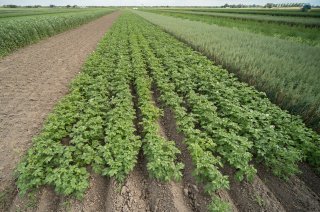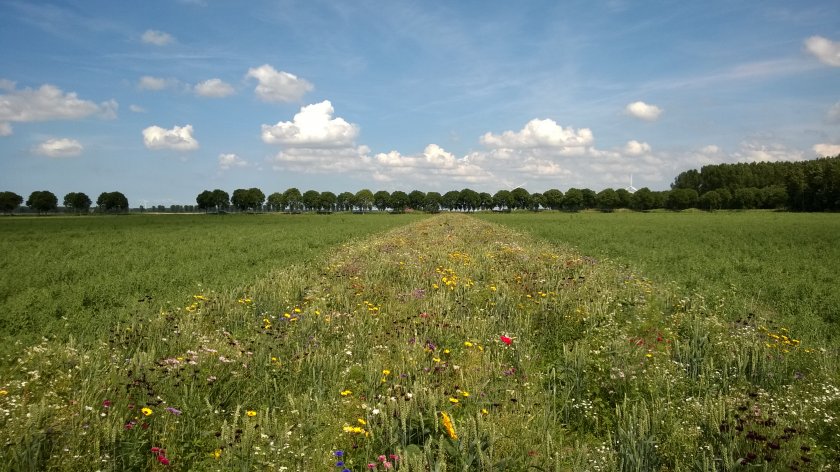
Blog post
Pioneering farmer Roy Michielsen about nature-based solutions
How to make friends with enemies of our enemies? That central question led to a nature-based solution for farmer Roy Michielsen of ERF BV. Since 2015, ERF BV has been applying basic principles of nature to farming by strip cropping. Now, five years later, he is convinced that this is the nature-based solution that he was looking for.
Strip cropping. Photo: ERF BV
Peas and flowers
One of his enemies are aphids, damaging his peas. How to attract natural enemies of aphids? In nature, natural enemies can be found in flower fields. So, he sowed flower strips in and around pea strips. For comparison, he sowed peas without flower strips on an adjacent patch as well. A strip with sticky traps were placed in both plots. The number of aphids and natural enemies caught were counted every week during the growing season. What happened? First, the number of aphids increased rapidly. A week later the number of natural enemies also increased stronger in the area with the flower strips compared to the field without flowers. So it worked! The trial was part of the 'stability through diversity' project, in which Wageningen University & Research and Louis Bolk Institute were involved.

Potatoes
Another enemy is phytophthora, a microorganism that causes potato disease. Would strip cropping with two different potato varieties combat phythophtora? Roy knew that on smaller scale this was done successfully, but would it work on his farm as well? ERF BV planted strips of the phytophtora-sensitive Ditta variety next to the Vitabella variety that is less sensitive to phytophthora. As comparison ERF BV also maintained a field with Ditta only. This trial was also part of the 'stability through diversity' project. To Roy, the outcome of this experiment was less convincing than the experiment with peas and flowers. Nevertheless, after a slight outbreak of phytophthora, the Ditta plants in the strips were less affected than in the monocultural field. To collect more data, the experiment continued in 2017 as part of a bigger strip cropping experiment. But at some point Roy had to make the decision to remove the potatoes, otherwise phytophtora would spread over the entire farm. Roy was glad that our researchers fully understand and respect his interests as a farmer. Trade-offs are part of life.
Strip width
Another trade-off that ERF BV had to make was about strip width. Roy knew that strips of 3 meter or narrower did have a positive effect on attracting natural enemies and on disease suppression. But some of their machinery is not suitable for such a narrow strip. Therefore, a minimum strip width of 6 meters is required and preferable even wider than 6 meters. So what about 6, 12 or 24 meter? What would be the optimum for both workability and effectivity? After three years, strips of 6 meter width was still four times more effective in attracting natural enemies than a regular field. Also, the variety of insects was richer in the strips than in the monoculture. Good news! This means that the right enemy of the farmer's enemies might be already present when his crops are about to be attacked. Roy could breathe a sigh of relief, because 6 meter is doable with his conventional machines.
The efficiency was better than expected!
Good neighbours
Roy learned that peas and flowers are good neighbours. What about other crop combinations? Since 2020 ERF BV alternate different crops and flower strips and try to find optimal combinations. This year, they created already 110 hectares of strip cultivation! Wageningen University & Research maps which crops thrive side by side and which do not. (Read more)
Climate change
Even though it is a less prominent issue for Roy, he does take into account the more extreme weather events due to climate change. He makes sure that the soil is covered, so heavy rainfall can be captured. One example is a grass strip next to a carrot strip. In summertime the grass is mowed. In fall it is a nice harvest path for the carrots next to the grass. This way, Roy has much less deep tractor rutting when the soil is wet. Unfortunately there is a drawback: grass attracts mice. Attracting mice is great for biodiversity, but not for our carrots, in Roy’s opinion.
Attracting mice is great for biodiversity, but not for our carrots.
Future challenges
Irrigation and manure spreading is still a challenge, since every crop requires a different treatment. Another issue is that at the end of each strip they have to reserve a few meters without crops. This headland is required to turn around with their machines and to come to the next fixed path between strips. They consider to combine headland with perennial flower strips to enhance biodiversity and to attract more natural enemies. Furthermore, Roy sees the advantage of switching to strip cultivation without having to invest in machines. Nevertheless, he wishes that more efficient machinery will become available that is suitable for strip cultivation. Roy would like to think about this actively, but development is not the expertise of his holding.
Attention
Apartment residents from Almere city have a great view on Roy’s farm and fields. Some people can recognise one crop in a big field, but don't recognise the individual crops in the mixture anymore. But it looks beautiful, they say to Roy. Most farmers are sceptic though. To those people Roy says that once you rearrange your parcel, the rest will follow.
Yes, there are challenges, but it is doable.
Roy generously shares his knowledge as part of a course that was developed with Wageningen University & Research. When we answer pending questions together, we can manage, in his opinion. He is convinced that strip cropping is the way forward. And we agree.